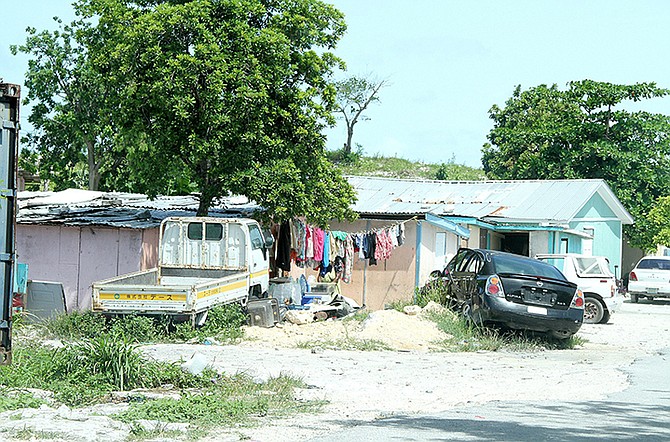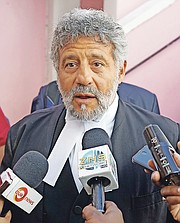By FREDERICK SMITH, QC
To many Bahamians, the informal communities that exist on New Providence and Abaco and some of the larger Family Islands are evidence of an invasion; signs of a hostile takeover or aggressive plague that must be eradicated by any means necessary. Meanwhile, the people who live in these communities are spoken of as if they are hostile aliens, dangerous social contaminants, hardened criminals who should be shown no mercy.
Not only is this prevailing attitude alarmingly cruel, cold-blooded and inhumane; it is also, legally and factually speaking, totally misinformed. As with most narratives born out of fear and distrust of those who are perceived as different, this desire to “cleanse” our society of supposedly dangerous foreign elements is built on a framework of falsehoods, half-truths and convenient myths.
Myth 1: Shanty towns were created by ‘illegal Haitians’
Many of these communities, today known collectively and derogatorily as “shanty towns”, were not created by irregular migrants from Haiti. Rather, they have their roots in decades-old government Crown Land grants to Bahamian farmers, who in turn hired labourers from all levels of society – men and women, local and foreign.
In many cases, the workers were allowed to live on the land and work it for a profit. In return, these occupants were expected to share a percentage of their crop with the landowner and perhaps pay some small amount in rent. Later, after the farmers had ceased operations, some allowed the workers to continue occupying the land.
Over the years, others joined these communities. Among them were of course individuals who had entered The Bahamas without proper permission; but many others were migrants working and living in the country legally. Others were Bahamians who befriended, formed bonds with and married those already living there, as well as locals who simply found themselves down on their luck with nowhere else to go.
In November 2014, when former minister of immigration Fred Mitchell launched his illegal and appalling crackdown on these communities, the first round of raids swept up more than 400 people – people whose rights were violated in the most egregious manner, whose property was destroyed and whose liberty was taken away. Over the next few days, however, more than half of these shanty town dwellers had to be released, because they were found to either be Bahamian citizens or individuals who were in the country legally.
Myth 2: The occupants have no right to be there
A second inconvenient truth is that regardless of their nationality, the occupants of these communities cannot be deprived of their homes or other property by arbitrary dictate of government. Article 27 of the Bahamas Constitution declares that “no property of any description shall be compulsorily taken possession of, and no interest in or right over property of any description shall be compulsorily acquired” without “securing to any person having an interest in or right over the property a right of access to the Supreme Court, whether direct or on appeal from any other authority, for the determination of his interest or right, the legality of the taking of possession or acquisition of the property, interest or right, and the amount of any compensation to which he is entitled”.
Far from being some kind of illegal invasion, the fact is these communities follow long Bahamian tradition; the acquisition of land through sustained and unchallenged occupation, what is called “adverse possession,” is the genesis of a great deal of the Generation Land held by Bahamian families across the country. It is also how traditional communities such as Bain and Grants Town came about.
The law also says that if a person occupies a piece of land for 12 or more years and develops that land, he or she can lay claim to the property through the Quieting of Titles Act. Many shanty town residents have been there 20, 30 even 40 years or more, and therefore could indeed have a claim if the matter went before the courts. In addition, according to the Building Regulations Act, if an irregular structure has stood uncontested for over a year, the government is prevented by law from taking any arbitrary action to remove it.
In other words, the people living in these communities cannot be deprived of their homes without first being afforded the opportunity to go before a judge and plead their case. Neither the PLP nor the FNM has the right to simply drive people off the land, bulldoze their homes and destroy their property, and any government that does so is breaking the law.
Myth 3: ‘Dirty Haitians’ are creating unsanitary conditions
Another misconception often taken as fact is that the “dirty illegal Haitians” in these communities are to blame for the often unsanitary conditions and the attendant health and safety risks. Bound up in this particular myth is a whole host of petty generalisations which are regularly used to justify the visceral aversion some Bahamians feel towards Haitians, who they tend to stereotype as disease-ridden, unhygienic and dirty.
Firstly, any person who labels another as “dirty” by nature because of the circumstances in which they are forced to live displays a shocking level of ignorance about the realities of poverty. Anyone who portrays the degradation involved in the struggle for survival as a matter of choice is clearly blind to the incredible privilege afforded to those lucky enough to control their own destiny. There, but for the grace of God, go all of us.
As to who is most to blame for the unsanitary conditions themselves, a 2013 report by the Bahamas Department of Environmental Health found that: “An emerging trend is the increasing number of Bahamians (or persons, who claim to be Bahamian) who live in or frequent these towns. Many of the long term shanty town occupants express that the ‘new arrivals’ do not have the same reverence for proper hygiene and respect for law and order resulting in the decline of the towns.”
Myth 4: Illegal shanty town dwellers are ‘taking over the country’
The last census in 2010 found the total population of The Bahamas at the time was 351,000, and that around 290,000 of them were Bahamians. In other words, according to the Department of Statistics, 61,000 non-Bahamians were living here. Of that number, 5,600 were North Americans, 1,700 South Americans, 1,700 Asians, more than 5,000 were Jamaicans and about 3,600 were from Europe.
Upwards of 40,000 are therefore presumed to be Haitians, and many Bahamians extrapolate from this that there are tens of thousands of “illegals” in the country. However, a great many Haitian nationals live in this country legally, whether on work permits, as spouses of Bahamians or under some other lawful arrangement. In addition, there are many thousands of Bahamian-born children of foreigners, including Haitians, who have a right to be registered as citizens upon application on their 18th birthday. And, as multiple recent rulings by The Bahamas Supreme Court have upheld, these individuals cannot be referred to as “illegals” as they have a right to be here.
According to the 2013 DEHS report, the combined number of shanty town dwellers in New Providence is somewhere around 2,000 individuals. In a population of approximately 250,000 people, this amounts to less than one percent. Do Bahamians really have any justification for vilifying these people as a plague of invaders who are threatening to take over the country? Is this perspective anything more than xenophobic, hate-driven scaremongering, which politicians tend to encourage and perpetuate in order to gain votes?
The real invaders
Meanwhile, there is a class of bona fide invaders who actually do pose a clear and urgent threat to land and resources which properly belong to the Bahamian people. Far from being denounced by the public and persecuted by the authorities, these invaders are honoured and celebrated; the red carpet is rolled out for them at every possible opportunity and fawning politicians regularly gift them economic benefits that Bahamians themselves will never be lucky enough to enjoy.
I refer to the seemingly unending stream of wealthy foreign investors who come here knowing they will be granted huge swathes of Crown Land for free or next to nothing. These insurgents and occupiers woo hapless politicians, sometimes with bribe money, always the promise of “jobs, jobs, jobs!” In reality they merely preside over a further entrenchment of the neo-plantation mentality in which rich, white foreigners are the masters and Bahamians are relegated to the menial tasks with little to no chance of job mobility or other betterment of their circumstances.
Meanwhile, they take our precious land and natural resources for their own use, often pollute and destroy the sensitive surrounding environment, then ship all of the real profits out of the country. Peter Nygard, Resorts World Bimini, Guana Cay and now Oban – we know the names and faces of these invaders well. What many Bahamians do not know, or do not wish to recognise, it these characters have done and are doing far more harm to our society and economy than shanty town dwellers ever could.
A humane solution
Obviously though, something must be done. No one can dispute that shanty town communities are plagued by unsafe living conditions, substandard building practices, pollution of the environment and serious public health risks. The solution of the last PLP government – and it would seem the intention of this new administration as well – is simply to bulldoze the homes, thereby destroying the lives of hundreds of human beings, many of them innocent children, many of whom have done nothing wrong in living there. These people now live in constant fear and distress that their entire world will be ripped away from them at any moment, a dreadful Sword of Damocles suspended over their head.
Human rights activists hope for a day when this sensitive and complex matter is not longer subject to blunt-force, brutal “final solutions” which tear lives and people apart. We hope our government will one day be sufficiently visionary and caring to approach it innovative thinking, fair and legal solutions and most of all, compassion and humanity. How long we will have to wait depends on whether or not this current FNM administration plans to live up to its promise to govern in a new way and protect the rights of all the people.
• Part 2 of this piece will examine a range of possible solutions to the shanty town issue that do not involve breaking the law or violating the rights of individuals.






Comments
Use the comment form below to begin a discussion about this content.
Sign in to comment
Or login with:
OpenID